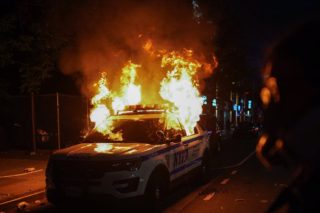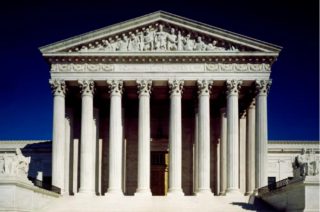
A police car burned in Brooklyn on Saturday night after clashes between demonstrators and officers.Credit…Chang W. Lee/The New York Times
Protesters who took to the streets in Minneapolis for the fifth straight night on Saturday met a more determined response from police officers and National Guard troops, as demonstrations escalated in dozens of cities across the country — an outpouring of national anger sparked by the death of a black man in police custody.
Soon after an 8 p.m. curfew took effect, the police in Minneapolis began arresting protesters and firing tear gas and other projectiles toward crowds, and the National Guard used a helicopter to dump water on a burning car.
The forceful response reflected the desire of authorities to halt the violent protests that have spread nationwide since George Floyd, 46, died after being pinned down by a white Minneapolis police officer. There were still reports of violence and destruction: a fire on the roof of a shopping mall, a person who shot a gun at officers, and a group of people throwing items at the polic. But state officials said around 11 p.m. local time that they were encouraged by the smaller crowds and apparent decrease in damage. Much of the city was empty shortly after midnight.
But even as aerial videos from Minneapolis showed police officers largely keeping demonstrators at bay, other cities were being overwhelmed, despite hastily imposed curfews.
Mayors ordered people of the streets in many of the nation’s largest cities, including Los Angeles, Chicago, Philadelphia and Miami. And governors in at least eight states, including Georgia, Kentucky, Ohio, Colorado and Tennessee, called up National Guard troops in an attempt to impose order, often with little success.
In Tennessee, the building that houses Nashville’s City Hall was set on fire. Two police vans in New York City were filmed plowing into protesters. In Washington, demonstrators set fires and smashed the windows of buildings near the White House. The police in Indianapolis said three people had been shot during the protests — not by police officers — including one person who was killed. And in Philadelphia, the Police Department said at least 13 officers had been injured during protests.
The demonstrations continued to escalate on Friday and Saturday even after Derek Chauvin, the former Minneapolis police officer who was recorded kneeling on Mr. Floyd’s neck until he lost consciousness, was charged with third-degree murder.
President Trump has harshly criticized the unrest, and Attorney General William P. Barr warned on Saturday that people inflicting the destruction could face federal charges. Gov. Tim Walz of Minnesota said the people defying curfews and trying to instigate police were no longer protesting police brutality, but rather seeking to exploit Mr. Floyd’s death for their own political motives.




